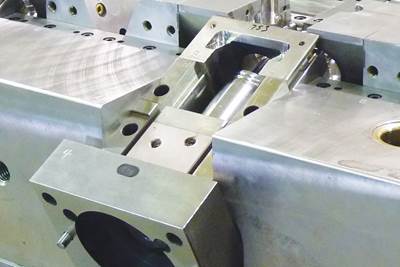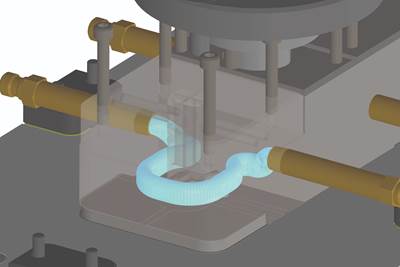Components of a Mold
Mold components are what make the mold work and the mechanisms used to deliver a quality end product. Key components include mold bases, pins, ejectors, lifters, bushings, guides and alignment devices. Mold components can be broken down into three categories: frame plates, frame components, and cavity tooling. Frame or base plates consist of the individual mold plates which can be seven plates in a stripper plate mold or even up to twenty plates or more, depending on the size and complexity. Frame components include all tooling that is within the frame that does not form the part. This includes guide or leader pins, bushings, return pins, interlocks, bolts, and seals. Tooling that may also be included in this category is ejector pins. Cavity tooling is the most critical and expensive tooling of a mold because it determines dimensional and aesthetic part features. It includes the cavities, cores, sleeves, and pins that directly form the part. Source

ESSENTIAL READING
VIEW ALLHow to Use Ultra-Precision Micro Tools, Molding and Automation to Unlock High-Volume Medical Device Miniaturization
Five key areas where a molder/mold builder applies tight-tolerance tooling and advanced molding solutions to enable high-volume production of micro-molded medical parts.
Read MoreStrategic Mold Venting – Placement and Method
Knowing where and how to vent a mold is critical for difficult areas and complex geometries.
Read MoreStrategic Mold Venting
Venting is one of the most crucial, but often overlooked, aspects of mold design and manufacturing.
Read MoreHow to Solve Core Pull Flash and Part Issues
Many mold problems can be solved by simply providing enough preload force on the core to prevent movement.
Read MoreStrategic Mold Cooling – Hot Spots
With complex plastic parts it can be difficult to deliver proper cooling to all potential hot spots. Here are strategies to help cool some difficult-to-cool areas.
Read MoreHow to Supply Cooling to Additive Tooling
Additive tooling provides limitless options for cooling a mold’s difficult-to-cool areas.
Read MoreLatest Mold Components News And Updates
Stainless Steel Water Manifold Assemblies Provide Safer and More Efficient Injection Molding
Plastixs announces its new Xtreme HiTemp manifold assemblies more efficient and safer injection molding.
Read MoreExpanded Air Poppet Valve Series Supports Molded Part Ejection
CUMSA expands Air Poppet Valve series with a smaller-size dimension and a first-time size offering in inches.
Read MoreCore Pins and Plugs Expedite Mold Venting
Molder’s World’s Vortex core pins or plugs provide a location-specific method for venting gas.
Read MoreMold Components: Sourcing Insights + Expert Tips
Mold components enable molds to work as they are the mechanisms used to deliver a quality end product. Access exclusive, online-only content, including a suppliers list, various mold component products, services and more.
Read MoreConventional and Self-Lubricated Mold Components Offer Various Benefits to Moldmakers
SelfLube offers bronze and steel components used in mold and stamping dies.The company offers conventional components as well as self-lubricated components. These graphited parts enable less maintenance as they do not require any additional lubricates.
Read MoreSpindle Gear Components Offer Moldmakers Greater Flexibility for Unscrewing Thread Cores
Hasco’s expanded gear range Z1500/… features simplified designs and a broad spectrum of accessories developed specifically for use in unscrewing tools, enabling smoother, more efficient production.
Read MoreFeatured Posts
Strategic Mold Venting
Venting is one of the most crucial, but often overlooked, aspects of mold design and manufacturing.
Read MoreHow to Solve Core Pull Flash and Part Issues
Many mold problems can be solved by simply providing enough preload force on the core to prevent movement.
Read MoreForces and Calculations Are Key to Sizing Core Pull Hydraulic Cylinders
To select the correct cylinder, consider both set and pull stroke positions and then calculate forces.
Read MoreDeep-Cavity Cooling Made Easy
G.A. Roeders uses an advanced cooling system employing gun drilling to deliver high-pressure water to quickly and evenly cool areas deep within a mold cavity.
Read MorePTXPO 2025: Innovations, Impressions and Inspirations
As MMT’s Associate Editor, I had the opportunity to walk the show floor as well as work in the MMT booth, and I’m excited to share my insights on the technology trends that caught my attention — both new and established within the industry.
Read MorePhysics of Side Actions: An Introduction to Elasticity and Thermal Expansion
Material elasticity and thermal expansion critically determine mold design performance and troubleshooting effectiveness.
Read MoreFAQ: Mold Components
Should I use standardized mold components?
There are many benefits to working with standard components. For starters, the leadtime on a project can be reduced. The time that would have been spent squaring up blocks, machining, heat treating and grinding all of the slide components can be used to focus on the molding area—cores, cavities, slide faces, etc. Programming time for the slide components is eliminated, and once the mold designer is tuned in to the idea of using standard slides, design time should also be reduced.
What about cost? It is debatable. Depending on how long you determine it takes to manufacture all of the components of a slide assembly and what you use for a shop rate, the price of standard slides could be considered a bargain or overpriced. You will need an accurate assessment of the time it takes to design and build a slide assembly.
How can I fix core pull flash and part problems?
Many problems can be solved by simply providing enough preload force on the core to prevent movement. Nonetheless, blocks and pins only provide a backstop to a core and often provide little to no active support to prevent movement. These methods rely on steel’s mass or volume to minimize flex and movement to yield a “good enough” result. In this way, there is always some reaction to the forces of injection from the perfect positional geometry, rather than a proactive preloading of metal into position.
How do self lubricating mold components work?
Using self-lubricating mold components has significant benefits, but only if the molder truly understands what these components are: essentially a conventional component with lubricant added in the form of graphite plugs. Graphite is a solid lubricant, so, for those molders who are used to working with liquid lubricants such as grease or oil, a solid lubricant may seem a little strange, and so might the graphite itself.
Graphite has a near-zero coefficient of thermal expansion, which means that it doesn’t expand and contract with temperature changes like ordinary substances do. It’s not a metal, but it conducts electricity like one. It also doesn’t melt. Instead, it remains a solid at temperatures ranging to 10,000°F and then becomes a gas. It’s not very strong, but it can be formed into composites with incredible strength.
Features and Functions
The main function of a self-lubricating mold component is to guide and control movement. Such a mold is typically made of aluminum bronze, an excellent bearing material, with embedded graphite plugs. The mating part of the mold (the one being guided) is usually made of hardened steel. As the two parts move relative to each other, the very slippery one-atom-thick sheets of graphite peel off and become distributed over the wear surface. With each cycle, a bit more graphite is distributed, so the process continuously replenishes. Graphite doesn’t evaporate and is relatively inert, so the lubrication it imparts is essentially permanent.
Although self-lubrication adds about 20 percent to the cost of a conventional component (one that must periodically be greased), there are several benefits for this extra cost:
• Maintainability. The need for periodic greasing is eliminated, which means, over the life of the tool, the savings in preventive maintenance (PM) is likely to be several times the upfront cost for self-lubrication.
• Reliability. Lubrication is always present, eliminating the risk of failure or shortened life due to skipped PM. Also, the absence of liquid lubricants means there is nothing to attract grit and other contaminants to wear surfaces.
• Simpler designs. With self-lubricated components, there is no need to make provisions for periodic lubrication, which removes a design constraint, potentially reducing costs and/or improving functionality.
• Clean operation. No liquid lubricants to drip or spatter on parts means a very clean operation with less scrap and rework.




























